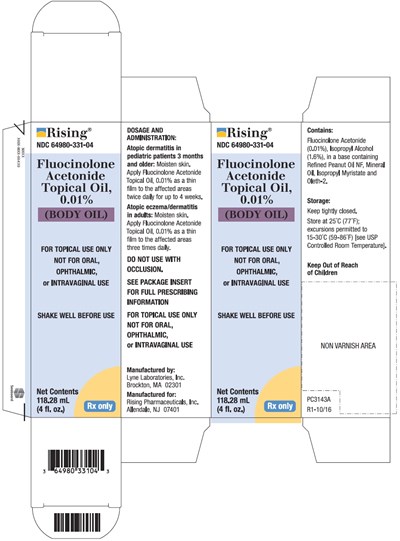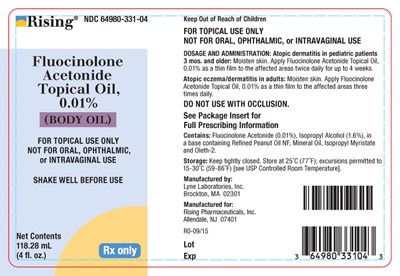Product Images Fluocinolone Acetonide Oil
View Photos of Packaging, Labels & Appearance
Product Label Images
The following 3 images provide visual information about the product associated with Fluocinolone Acetonide Oil NDC 64980-331 by Rising Pharma Holdings, Inc., such as packaging, labeling, and the appearance of the drug itself. This resource could be helpful for medical professionals, pharmacists, and patients seeking to verify medication information and ensure they have the correct product.
box - Body Oil

This is the description of a medication named "Fluocinolone Acetonide Topical Oil, 0.01%". It is manufactured by Lyne Laboratories, Inc. for Rising Pharmaceuticals, Inc. It is used for treating atopic dermatitis in pediatric patients aged above 3 months and atopic eczema/dermatitis in adults. The medication comes with dosage instructions and must be used topically only. This topical oil comes in a 118.28 mL bottle and contains fluocinolone acetonide (0.01%), isopropyl alcohol (1.6%), and other ingredients. It must be stored at 25°C with variations permitted between 15-30°C. Further details are provided in the package insert. The code "NDC 64980-331-04" is also present.*
bottle - bottle body oil

This is a prescription-only topical medication called Fluocinolone Acetonide Topical Oil, 0.01%, packaged in a 118.28 mL bottle for use in treating atopic dermatitis, a skin condition. It is not intended for oral, ophthalmic, or intravaginal use and should be applied to moistened skin, twice a day in children aged three months and older, and three times daily in adults. It should not be used with occlusion. The medication has Fluocinolone Acetonide (0.01%), Isopropyl Alcohol (1.6%), and other ingredients, including refined peanut oil, mineral oil, and oleth-2. The medication should be used with caution and is available in the US under the USP Controlled Room Temperature.*
* The product label images have been analyzed using a combination of traditional computing and machine learning techniques. It should be noted that the descriptions provided may not be entirely accurate as they are experimental in nature. Use the information in this page at your own discretion and risk.
